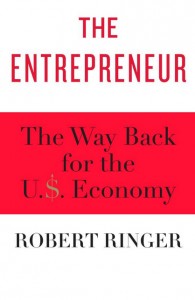Asking the Right Questions
Posted on March 14, 2006 by Robert Ringer
Though every death is equally important and painful to the deceased person’s family, perhaps the most difficult death for the average person to comprehend is that of Dana Reeve, who died on March 6. Not only was she young (forty-four), she was one of a growing number of nonsmoking women who have been afflicted with lung cancer.
Lung cancer kills more people than colon, breast, and prostate cancers combined — roughly 160,000 Americans each year. Remarkably, a full 20 percent of lung-cancer patients are nonsmokers, and 10 percent have never once lit up a cigarette.
Dana Reeve’s husband, of course, was Superman himself — Christopher Reeve — who has been dead now for almost a year and a half. Not everyone liked Dana’s politics, but it was impossible not to respect her as the ultimate stand-by-your-man gal. Disease and death aren’t about politics; they’re about tragedy, and tragedy transcends political boundaries and bickering.
So, we’re back to the same old question: Why do bad things happen to good people? It’s a question that has haunted mankind for centuries, but perhaps there’s a more important question we should be asking. The question I’m referring to is this: With all the money and brainpower we have at our disposal, why is it that we can send space probes to Mars but we can’t find a cure for the insidious diseases and disabling medical conditions that cripple and kill us?
I am convinced that most Americans have their priorities scrambled. The late and legendary Andrew Galambos, the free-market cult figure whom Harry Browne dubbed “the unknown libertarian,” was purported to have taught those who attended his lectures that almost everything everybody believes is wrong.
I never had the good fortune of meeting Andrew Galambos, who died in 1997, but firsthand observation has made me wonder if his view of mankind wasn’t a bit understated. If an alien from another galaxy were to land on Earth tomorrow and take a couple of days to observe what’s going on in our world, he/she/it might well arrive at the conclusion that everything everybody believes is wrong.
Now, before I go off on a ten-thousand-word tangent, let me bring this all back to the unsolved mysteries of disabling injuries and horrific diseases. Why can’t we seem to get a handle on these silent predators — predators that affect virtually every family in the world?
I do not pretend to possess a great deal of knowledge about the massively complex subject of stem-cell research. Nonetheless, I was fascinated by a segment that 60 Minutes recently did on this topic. The foundation for the 60 Minutes story was an interview that Ed Bradley did with Dr. Hans Kierstead, who has spent years working on stem-cell research.
Kierstead claims to have made it possible for laboratory rats with paralyzed hind legs to walk again by injecting them with human stem cells. He believes that injecting embryonic stem cells into human beings addresses every disease known to mankind.
However, many knowledgeable folks in the stem-cell-research arena are critical of Kierstead’s findings. He himself admits to being concerned about giving people false hopes, as well as possible side effects from stem-cell injections. Nevertheless, he feels strongly that it is his moral duty to press forward.
When Bradley expressed a concern that so many people have about stem-cell research — the ethical issue of destroying human life — Kierstead replied, “So, let’s use it instead of discarding it. If you think that is a holy thing, then value it, treasure it, and keep it. Use it for research in the betterment of lives. Don’t throw it away.”
As I said, this is a massively complex topic, and another one of those subjects that has a tendency to work people into a white heat of anger on both sides of the fence. With that caveat, I shall tread forward with a great deal of apprehension. Though I plead ignorance on the scientific issues involved, I feel compelled to at least weigh in on the ethical issues.
While I don’t know much about stem-cell research, I do know about the pain and suffering that my sister endured when dying of lung cancer. I know what my eldest daughter goes through trying to cope with multiple sclerosis. And I know what my friend Jim Blanchard had to deal with throughout his adult life as a paraplegic.
What the Christopher-and-Dana Reeve story reminds us of is that these cripplers and killers recognize no boundaries. They cross geographic lines, religious lines, racial lines, and social-status lines. They give no special break to anyone, not even to a fairytale couple like Superman and his adoring wife. All the fame and fortune in the world didn’t give a pass to Johnnie Cochran, Ronald Reagan, or Peter Jennings.
There is little question that some unknown percentage of the population has contracted illnesses such as cancer, heart disease, and diabetes primarily as a result of their own actions (e.g., bad eating habits) and inactions (e.g., lack of exercise). But millions of other people have been blindsided by these diseases even though they lived healthy lifestyles focused on proper diet, exercise, and low stress.
Likewise, though many paraplegics and quadriplegics have invited tragedy into their lives as a result of irresponsible behavior (e.g., drunk driving), I would guess that a majority of them have simply been victims of unforeseeable circumstances. Ditto with people who suffer from a variety of diseases, such as muscular dystrophy and cystic fibrosis.
So, to me, the questions we should be asking revolve around how federal and state governments are spending our tax dollars. If politicians want to play cowboys and Indians with “terrorists” around the world, I guess they’re going to do it regardless of how many people are against it. But I feel compelled to point out that the bulk of research that led to a cure for poliomyelitis was done while the U.S. financed World War II and the Korean War. As a result, as quick as you could say Jonas Salk, poliomyelitis was virtually eradicated.
So it’s a fair question to ask how multiple sclerosis, muscular dystrophy, amyotrophic lateral sclerosis, and dozens of other killers got left behind. I’m perplexed as to why Harry Browne died from a disease with which even the general public has been familiar since the legendary Lou Gehrig’s death in 1941.
I think the answer is that we live in an insane world that Andrew Galambos had pegged perfectly: Almost everything everybody believes is wrong.
We need to get our priorities straight. Disease and accidents pose a far greater threat to our safety than terrorists. Slightly less than three thousand people were killed by terrorists on 9/11. It was a horrific crime, and one that none of us shall ever forget, but we need to keep it in perspective. In the same year as the 9/11 attacks, more than fifty times that number of people died from lung cancer alone.
Since then, we’ve spent hundreds of billions of dollars fine-tuning our war machine and putting it into action when the powers that be say it’s necessary to do so. We could argue forever as to whether or not good or bad has resulted from our war efforts, but the more important question is: Can you imagine what spending even $100 billion a year would do for the War on Disease?
Unfortunately, you and I know that it’s never going to happen so long as we leave the job up to government. Those guys on Capitol Hill are far too busy trying to push through their favorite pork-barrel projects to be bothered with something as mundane as eradicating disease and paralysis. The government can’t and won’t fight disease any better than it does anything else — and it doesn’t do anything very well.
In my view, the solution is to make an irresistible proposition to private enterprise. Loosening up on FDA testing requirements, limiting exposure to personal-injury lawsuits, and granting tax-free status comprise a good bundle of incentives for starters. And, above all, make it outrageously lucrative for companies to come up with cures — not merely medications to relieve symptoms or keep people alive longer.
(Keep in mind that the reason a cure for a “disease” as common as asthma is nowhere in sight after all this time is because pharmaceutical companies make billions of dollars selling medications to prevent or control asthma attacks.)
How would you like an opportunity to sell a cure to a market of more than 70 million individuals in the U.S. alone? That’s how many people in this country have one or more forms of cardiovascular disease (CVD).
Whether anyone likes it or not, the best way to motivate the marketplace to solve our medical problems is to make it financially worthwhile to the people and companies who have the brainpower and resources to do it.
But don’t hold your breath waiting for it to happen.










